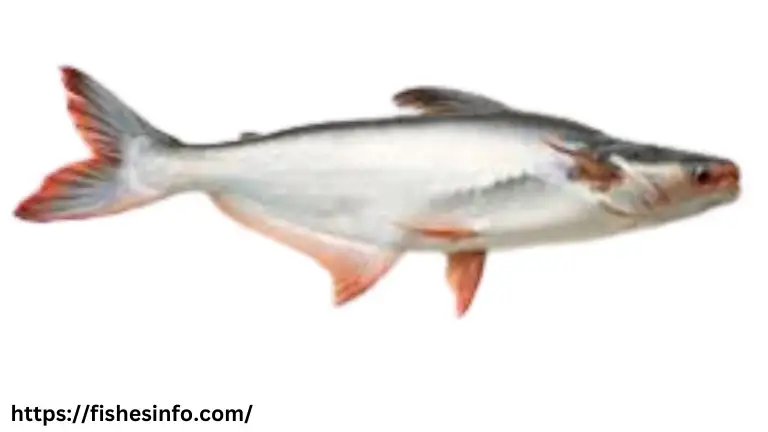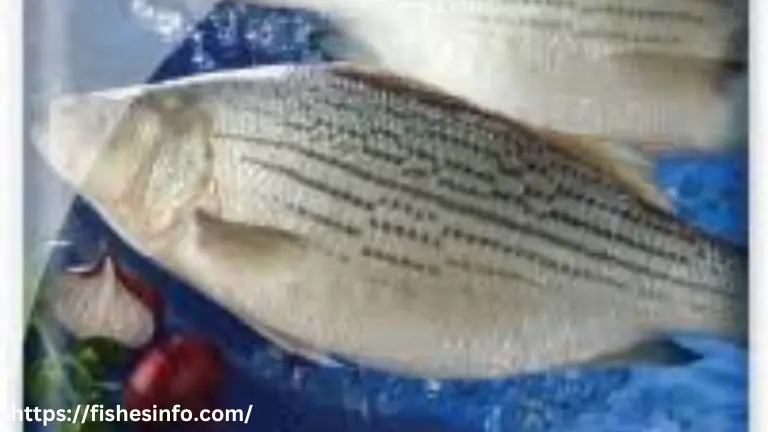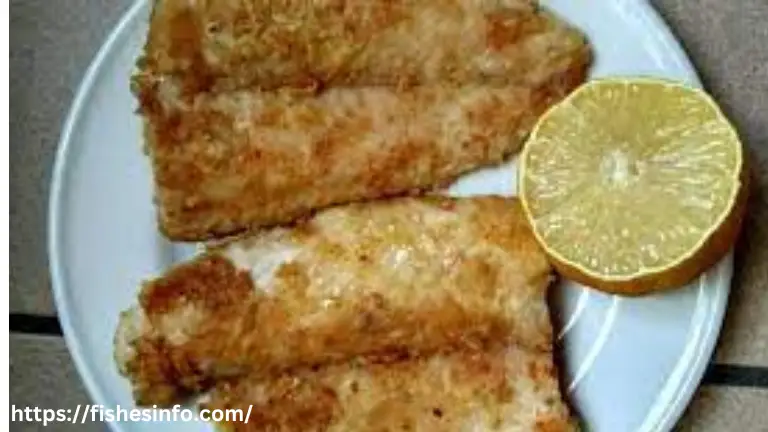The term Fish is a wide phrase encompassing a huge and varied collection of aquatic vertebrates. These organisms inhabit diverse aquatic environments, such as oceans, seas, lakes, rivers, and ponds. Fish occur in countless kinds, each with unique traits, habitats, and culinary characteristics, making them a key component of global cuisines and cultural activities.
In this article, we will talk about pangasius fish, its characteristics, scientific classification and nutritional benefits as well as its side effects. We will also look into the Phrase “What fish is Pangasius”.

What is Pangasius fish?
Mostly people are confused about the question of what is a Pangasius fish. The scientific name of Pangasius fish is referred to as Pangasius bocourti. It is a type of freshwater fish native to the Mekong as well as Chao Phraya river basins in Southeast Asia. It is frequently to as “Pangasius” or “Pangas,”.
This Fish is known for its quick development rate and suitability for aquaculture. The name “pangasius” is frequently used to particularly refer to the economically significant basa fish or P. bocourti. The word “Pangasius Pangasius” is also used to call this fish.
It has become a major species in the global seafood industry due to its mild taste, creamy white flesh, and cost-effectiveness.
It is frequently kept in fish farms and is noted for its fast transformation of feed into flesh. It is typically served in fillet form and is popular in different culinary uses, such as chips and fish, fish tacos, and baked or cooked fish dishes.
While it is commonly eaten and has a place within the seafood industry. It has also attracted attention to environmental sustainability concerns linked with particular production practices. As with any seafood option, consumers need to be mindful of the source and methods of farming while buying its products.
Pangasius pangasius
Pangasius pangasius is also known as Pangas catfish. It is a species related to Shark Catfish. this fish is mostly found in salinated fresh water in Pakistan, India, Bangladesh and Myanmar. This species has been introduced in Vietnam and Cambodia. This fish grows up to 9.8 ft in length or 3 meters.
Pangasius pangasius Characteristics
- Pangasius pangasius, also known as Pangas catfish or Pangas, is native to South and Southeast Asia.
- It has an elongated body and a flattened head, with whisker-like barbels around its mouth.
- This species is extensively farmed in aquaculture due to its rapid growth rate.
- It is valued for its adaptability to different environmental conditions.
- It is an important food fish, popular for its mild taste and white, flaky flesh.
Pangasius bocourti fish
Pangasius bocourti fish, generally known as the Pangasius or Swai, is a fish that lives in freshwater species related to the Pangasiidae family.
It is frequently used in aquaculture due to its quick growth, flexibility, and comparatively inexpensive cost of production. The fish has a moderate and neutral flavour, with white, flaky flesh which makes it ideal for numerous culinary uses. Commonly supplied in fillet form, it is widely used in recipes such as fish tacos, fish & chips, as well as baked or grilled fish cooking.
What is Basa Fish? | Pangasius Basa fish
“Pangasius basa,” commonly referred to as “Basa fish” or simply “Basa,” is a type of freshwater catfish belonging to the Pangasiidae family. Native to the Mekong River Delta in Southeast Asia, particularly in Vietnam, Cambodia, and Laos, Basa fish has gained popularity in the global seafood market.
It’s crucial to note that the term “Basa” is commonly used together with other comparable Pangasius species, such as Pangasius bocourti. Like other species, Basa has been developed through the aquaculture sector, which leads to its accessibility and affordability in the market for seafood.
Striped Pangasius Fish
Striped Pangasius fish are mostly raised on farms in southern Vietnam, in a place called the Mekong Basin. These fish don’t have scales and live in freshwater, similar to Tilapia. They’ve become very popular in the United States over the past 10 years. Originally, people called them Basa or Catfish, but now the FDA only allows them to be called Striped Pangasius, Swai, or Tra.
This change in names has caused some confusion, so the safest way to know what you’re buying is to look at the Pangasius scientific name: Pangasius hypophthalmus. These fish grow quickly (in about 6-9 months), so there’s always a steady supply, and you can find them all year round.
There are two kinds of these fish: Basa and Swai. Locally, people prefer Basa because it has thicker fillets and whiter meat. Swai, on the other hand, has a better chance of surviving and converts food into its body better. Usually, it is more expensive than Swai. Most of the fish imported into the U.S. these days are reported to be Swai. Other places like the European Union and Australia also like these fish.

Alternative names of Pangasius
There are many Alternative names for this fish which are mentioned below.
What is Pangasius fish in English?
Most people search the question of what is pangasius fish called in English. Pangasius in English is simply known as “Pangasius”. However, its other market name is Stripped Pangasius. Swai and Tra.
Pangasius Fish Name in Urdu
If we talk about the pangasius fish in Urdu-speaking culture then it is called “Tarkandi Machhli”. Urdu is a major language mostly spoken in South Asia. Pangasius in Urdu is known as “پینگاسیس” (pronounced as “pingaasius”). Pangasius fish Urdu name is most commonly searched by people who are Urdu Speaking and have a great interest in Seafood.
Pangasius Fish in Chinese
China is the largest country population-wise. Here this fish also has its significance.In Chinese, it is known as “斑节鲶鱼” (Bān jié nián yú) or “平安鱼” (Píng’ān yú).
Pangasius hypophthalmus in Tagalog
For Pangasius fish, which is regularly imported and sold in markets, it could be called simply “Pangasius” or “Cream Dory” in the Philippines. It’s important to remember that the naming rules for imported fish kinds might sometimes change. Pangasius in Tagalog is also known as “Bangus-Bangus”.
Pangasius in Hindi
India is a major country according to Population in the world. Most of the people living here speak the Hindi language. Pangasius in Hindi is commonly referred to as “पैंगेसियस” (pronounced as “paingesis”).
Scientific Classification of Pangasius Fish
| Scientific Classification | Names |
|---|---|
| Kingdom | Animalia |
| Phylum | Chordata |
| Class | Actinopterygii |
| Order | Siluriformes |
| Family | Pangasiidae |
| Genus | Pangasius |
| Species | Pangasius hypophthalmus |
| Additional Information | Names |
|---|---|
| Market Name | Pangasius fish |
| Common Name | Pangasius, Striped Pangasius, Swai, Tra |
| Country of Origin(s) | Primarily Vietnam |
| Method of Harvest | Farm-raised; primarily in the Mekong Basin of southern Vietnam |
Pangasius Fish Nutrition Calories
| Nutrient | Amount per 100g |
|---|---|
| Calories | 90 kcal |
| Protein | 16.5 g |
| Total Fat | 2.5 g |
| Saturated Fat | 0.7 g |
| Cholesterol | 45 mg |
| Sodium | 50 mg |
| Total Carbohydrates | 0 g |
| Dietary Fiber | 0 g |
| Sugars | 0 g |
| Vitamin D | 5.4 mcg (27% DV) |
| Calcium | 11 mg (1% DV) |
| Iron | 0.4 mg (2% DV) |
| Potassium | 310 mg (9% DV) |
| Omega-3 Fatty Acids | 0.2 g |
| Omega-6 Fatty Acids | 0.3 g |
The figures are approximate as well as can vary depending on factors that include cooking methods and individual product variances.
Pangasius Fish Health Benefits
Such as many other varieties of fish, it also offers various health benefits when eaten as part of an appropriate diet. Here are some of the potential Pangasius fish benefits:
Protein Rich Source
This is an excellent source of high-quality protein, needed for muscle development, repair, as well as overall body maintenance.
Availability of Omega-3 Fats
Although not as rich in omega-3 fatty acids as certain fatty fish, it still contains these essential fats that support heart wellness and may have anti-inflammatory qualities.
Low in Saturated fat
It is generally low in saturated fat, which makes it a heart-healthy alternative when compared with some other protein sources.
Vitamins and Minerals
It supplies critical elements such as vitamin D, B-12, and phosphorus, as well as the element selenium which improves overall health and well-being.
Body Weight Management
Being a low-calorie as well as protein-rich food, it can be a smart choice for persons striving for weight control or weight loss.
Easy food Digestion
It has a moderate flavour and soft texture, making it simple to digest, which might be good for persons with digestive sensitivity.
It’s essential to keep in mind that the health benefits can be enhanced when it is cooked and prepared appropriately, such as grilling, cooking, or steaming rather than deep-frying. Additionally, purchasing fish from recognized and responsibly handled sources might boost its nutritional profile.
As with any nutritional component, moderation and diversity are crucial, and a person’s dietary needs may differ. If you have specific health problems or conditions, talking with a healthcare practitioner or a qualified dietitian is a good idea for individualized advice.
Pangasius Fish Side Effects
Like any other form of fish, is usually regarded as secure and healthy when used as part of a well-rounded diet. However, as with any dietary product, there can be concerns and potential adverse effects to be aware of:
Allergies
Some persons may be sensitive to fish, especially Pangasius. Allergic reactions can range from moderate to severe and may involve symptoms like hives, swelling, breathing problems or stomach difficulties. If you fear an allergy, get medical attention.
Contaminant Risks
Like other fish, it may include environmental toxins such as metals that are toxic and pollution. It’s essential to choose fish from reliable suppliers, and pregnant women and small children may be told to reduce their intake of particular fish owing to potential mercury concentration.
Preparation and Cooking
Pangasius, like any fish, should be thoroughly prepared to avoid the danger of foodborne infections. Thoroughly boiling fish eliminates dangerous bacteria and parasites.
Sustainability Concerns
Some Pangasius farming methods have sparked environmental and sustainability issues. Choosing fish from reputable as well as responsibly managed suppliers can help solve these concerns.
As with any nutritional component, moderation as well as variety are crucial. If you have special health issues or conditions, it’s advisable to consult with a doctor or a qualified dietitian for personalized guidance.
Pangasius Fish Recipe
Guidelines for Cooking Delicious Pangasius Fish
Warm up the oven.
Turn the oven on to 375°F, or 190°C.
Get the marinade ready
Olive oil, the zest of one lemon, lemon juice, chopped garlic, dry thyme, dried rosemary, salt, and pepper should all be combined in a small bowl. Blend thoroughly to produce a tasty marinade.
Fish should be marinated
The Pangasius fillets should be put on a baking dish. Make sure each fillet is well coated by brushing it with marinade on both sides. To allow the spices to seep into the fish, marinate it for at least 15 to 20 minutes.
Cook the Fish
The pangasius fillets should be baked in the preheated oven for 15 to 20 minutes, or until a fork can easily flake the fish. Depending on the size of the fillets, cooking times can change.
Add a garnish and proceed to serve
After the fish is done, sprinkle it with freshly cut parsley. You can serve the fried Pangasius with your preferred side dishes or over rice.
Lemon slices for serving are optional
To add even more citrus taste, scatter lemon slices on the serving plate.
With its light and tasty dish, this fried lemon herb Pangasius recipe brings out the natural flavour of the fish. To suit your tastes, add or subtract seasoning and herbs. Savour your food!

Pangasius Fish Taste
Pangasius taste is moderate and generally neutral. It has white flesh that is noted for being flexible and easily adaptable to many seasonings and cooking ways. The mild flavour makes it suited for a wide range of culinary uses, permitting it to take on the taste of supplementary herbs, spices, or sauces.
The flesh is flaky when grilled, contributing to its attractiveness in numerous cuisines. Some refer to its taste as similar to other moderate white fish species, and its neutral nature makes it a popular choice for people who want a gentler seafood flavour.
Frequently Asked Questions (FAQ)
Is Pangasius Fish Healthy?
Most people ask the question “Is pangasius healthy”. Yes, It is a healthy choice as it is low in calories, rich in protein, and a good source of omega-3 fatty acids. It contains low Saturated fat, high-quality protein, Vitamins and minerals.
Is Pangasius fish safe to eat during pregnancy?
Yes, Pangasius fish in pregnancy is a good source of lean protein and omega-3 fatty acids, which are beneficial for fetal development. In addition, pregnant women should speak with their healthcare physician or a trained dietitian to talk about their particular dietary needs and any special issues connected to fish use during pregnancy. Pangasius fish pregnancy is a serious matter of concern for the ladies.
Is Pangasius Fish Halal?
Yes, it is considered halal. The acceptance of eating Pangasius fish, or any other form of fish, in Islam is typically deemed Halal (permissible) for Muslims. In Islamic dietary standards (Halal), fish is typically considered Halal, and there are no special limitations on it.
However, it’s crucial to note that the Halal status might also depend on aspects such as how the fish gets processed and handled, and if it follows certain Halal criteria. Muslims who adhere to dietary regulations may choose to verify that the fish is processed in conformity with Halal procedures.
Individual preferences and interpretations may differ, thus individuals wanting Halal meals should check with their regional Islamic authorities or Halal certification organizations for particular standards and recommendations.
Is Pangasius Fish Good for Weight Loss?
Yes, it can be an excellent choice for weight loss due to its low-calorie, nutrient-rich, high-quality protein and fat content.
Is Pangasius Fish Good for Health?
Yes, It is good for health due to its high protein content and low-fat levels.
Can Dog Eat Pangasius Fish?
Yes, dogs can eat Pangasius fish. Always make sure the fish is fresh, cooked properly, and provided in a way that corresponds with your dog’s specific nutritional needs. If you have any worries or questions regarding feeding fish to your dog, look for professional guidance from a veterinarian.
Does Pangasius Fish have Scales?
Pangasius fish, particularly the commonly eaten species Pangasius hypophthalmus, often do not have scales. Pangasius is distinguished by soft and scaleless skin. This is in contrast to certain other fish species that have scales wrapping their skin.
The lack of scales streamlines the cleaning process for Pangasius, as there is no need to measure the fish before cooking. However, it’s crucial to remember that individual differences may exist, as well as the information supplied here is an overall feature of Pangasius fish.
Does Pangasius Fish have Omega-3?
Yes, it does contain Omega-3 fatty acids. While Pangasius may not be as abundant in omega-3 fatty acids as certain other fatty fish, it still includes these healthy fats that are necessary for the baby’s brain as well as eye development
Pangasius Fish is it safe to eat?
Yes, it is safe to eat. It is usually safe to consume when acquired from reputable and authorized vendors as well as prepared and cooked appropriately. Pangasius is extensively consumed all over the world and is recognized for its mild taste and white, flaky flesh.
What does Pangasius pangasius eat?
Pangasius fish eat various types of food including small fish, insects, crustaceans, and plant matter.
Is pangasius fish high in mercury?
The Pangasius fish mercury level is usually regarded as low. It is a kind of freshwater catfish that is recognized for having reduced mercury levels compared to some larger predatory fish. As Pangasius mercury level is low it is safe to use.
What is pangasius fillet?
“Pangasius fish fillet” relates to the boneless, without-skin slices of meat from the Pangasius fish. These fillets are recognized for their mild flavour, white meat, and flaky texture. Pangasius fillets are often employed in numerous culinary applications, such as grilling, frying, baking, or steaming. They are adaptable and can be coated and served in numerous ways according to various recipes. Pangasius fish fillets are commonly picked for their price and accessibility in the fish and seafood market.
Conclusion
In summary, Pangasius fish, with its mild flavour, white crisp flesh, and flexibility in a variety of culinary applications, stands out as a flexible and affordable seafood alternative. Pangasius is well-liked by a broad spectrum of customers looking for a lean and nourishing protein source because of its reasonable price.
Its taste is very neutral, but what makes it appealing is how well it takes on flavours from various seasonings and cooking techniques. A sustainable and pleasurable dining experience is enhanced by choosing Pangasius which is supplied responsibly, as is the case with any seafood. Baked, grilled, or fried, pangasius is a tasty and easy addition to a wide variety of international cuisines.
- Amberjack Fish: Myths, Facts and Surprising Truths You Won’t Believe
- What are the Advantages of Composite Fish Culture?
- What is Red Snapper? Nutritional Values, and Exclusive Health Benefits
- How to Cook Delicious Sankara Fish Fry Recipe?
- Vanjaram Fish Top 10 Health Benefits You Need to Know

